#accessibledaytrips
Explore tagged Tumblr posts
Text
Peugeot Expert Campervan Conversion: Insulating and Installing Vinyl Flooring
Welcome to the third instalment of our camper conversion series! In this post, we'll start by guiding you through the process of insulating your van's floor. Once the insulation is in place, we’ll move on to reinstalling the plywood floor and finish with vinyl flooring. You'll find a step-by-step guide along with helpful tips and tricks for your own conversion project.
A full walkthrough video is included at the bottom of the page.
What You'll Need
Item List
10mm sound deadening/insulation roll
Aluminium foil tape
Vinyl flooring of your choice
Adhesive spray
Tools Used
Electric screwdriver
Stanley blade
Scissors
Fabric scissors
Measuring tape
Step One: Measuring Insulation
For this step we used:
10mm Sound deadening/insulation roll
Measuring tape
Scissors
Aluminium foil tape
After removing the plywood floor in part one of the series, we're now left with a blank canvas to work with.
We started by measuring around the trim and wheel arches of the van. Like in previous steps of the conversion, we used cardboard to transcribe any shapes onto the insulation to make sure we'd get a good fit.
After we were happy with our first measurements, we moved on to the backside of the van.
At the far end of the van, we measured around the trim, which would remain exposed, this time drawing the markings on the reverse side by eye. I found this method surprisingly effective.
Step Two: Installing the Insulation
After the insulation was cut to shape, we separated the piece into two sections. This would make installation easier and allow us to make any adjustments where needed.
Once we were happy with the measurements, we were ready to stick down our first pieces.
Note about our method
I avoided using a wooden frame on the floor, as I didn't want to lose any headspace while sitting in the van. Initially, the plan was to use 10 mm wood to leave space for the insulation, but after realising the ribs in the van's floor were around the same size, I didn't want to raise it any more than needed.
This ended up making reinstalling the floor more difficult later on, as we needed to drill extra holes to ensure the warped plywood sat evenly when fastened. If I were to do this again, I would glue a wooden frame down and screw into it, rather than the van floor.
After that, we focused on insulating the remaining exposed areas of the floor. To maximise our materials and minimise waste, we cut the insulation into smaller pieces, the width of the insulation roll, rather than one long piece.
Once the floor was completely covered, we applied aluminium foil tape along the seams where the insulation pieces met, completing the final step of the insulation process.
Step Three: Cutting Out The Vinyl Flooring
Tools used:
Fabric scissors
Stanley knife
Pen
We started by laying down the vinyl flooring and then placed the original plywood floor on top.
Using the plywood as a stencil, we traced its shape onto the vinyl.
Step Four: Installing Vinyl Flooring Into The Van
Tools used:
Adhesive spray x2
Level or metre stick to flatten out the floor
Fabric scissors/knife for adjustments
After cutting out the vinyl flooring, the next step was to reinstall the plywood floor in the van.
Once the plywood was back in the van, I placed duct tape over the point where the two sections met to make the surface smoother before installing the vinyl.
After that, I rolled out the vinyl and checked if it fit correctly, making some adjustments around the wheel arches, which were now a little narrower after the insulation was installed.
We began by applying adhesive spray to the surfaces at the front end of the van after ensuring everything was lined up correctly. Once that first section was firmly in place, we rolled up the flooring and continued applying adhesive, working our way back in sections. I'd recommend using a long, flat object, such as a metre stick or a level, to smooth out the floor as you lay it down to avoid any bumps or bubbles.
Once the floor was fully adhered, I used a Stanley knife to trim the edges so there was no overhang, which would make installing the protective trip easier later on.
Step Five: Installing Trim
The first step was to measure and cut the upper section of the trim. I made cuts at each point where the trim would need to bend.
When there were the bends would cause the trim to fold over itself; I marked the point where they met and used this marking to cut out a V-shape. This would allow the pieces to fit together smoothly.
Once I was confident with the measurements, I started sticking down the top section of the trim. I did this part first because it would be the most visible. Since these top sections were cut, I was able to remove the adhesive tape piece by piece and stick down each part individually.
I then wedged the trim down firmly to make sure it would stick properly. Finally, I filled in the gaps that were created when the trim was bent at an angle. I filled these gaps in by cutting small pieces from the unused trim and placing them in the openings. I used a small amount of adhesive spray to secure these pieces and cleaned up any excess with acetone after they were fully set.
What's Next?
In the next instalment of our campervan conversion series, we’ll be installing a roof vent for improved airflow in the van. For more van content, visit my YouTube channel here.
Click here for a full list of all our campervan conversion posts
For links to all the items used click here
#campervan#campervanconversion#howto#peugeot#peugeotexpert#tutorial#accessibledaytrips#vanlife#insulation#vinylflooring
1 note
·
View note
Text
Accessible Hobbies: Swimming

When living with a chronic illness, trying new things can be daunting, especially when it comes to finding a new hobby. In our "Accessible Hobbies" series, we will explore a variety of hobbies that are suitable for people living with long-term health conditions.
Why are hobbies important?
Research shows that people who regularly take part in hobbies feel less stressed and show fewer signs of depression. This is important for everyone, especially those living with a long-term illness.
No matter your passions, interests, or physical ability, there is a hobby for everyone. The most important thing is that it's fun and meaningful to you.
In this blog post, we will look at the positive effects of spending time in water, as well as some useful things to consider before you take the plunge.
Why should I try swimming?
The full-body sensation of swimming promotes mindfulness, providing a much-needed escape from the stresses of everyday life while enhancing overall mental well-being. Studies have shown that spending time in water stimulates the autonomic nervous system, which can help lower blood pressure, reduce the stress response, and decrease inflammation.
Swimming is very versatile and can be enjoyed by people of all abilities. You are free to do what feels right for you and keep any exercise at a comfortable level. Whether you’re swimming laps, doing light water exercises, or just relaxing by the pool, any small activity or even just a change of scenery will have a positive impact on your well-being.
If you find it challenging to exercise or stand for long periods of time, being in the water can offer the extra support you need. The buoyancy of water alleviates pressure on joints and muscles, allowing individuals of all fitness levels to take part in exercise.
Finally, swimming offers social benefits as well. Joining a swim club, participating in group classes, or even just visiting the pool with a friend can build connections with others and create a supportive community that will motivate you to stay active.
Click here to learn about swimming and POTS/Dysautonomia
Things to consider before you take the plunge

When planning your first dip, look for an accessible pool that can accommodate your needs, whether it is wheelchair-friendly access routes, rails to hold on to, or steps to enter rather than a ladder. If your health condition is heart or blood pressure related, avoid saunas and hot tubs due to the increased risk of fainting.
You should also make sure the pool has a lifeguard if you are concerned about your reaction to the water, or alternatively, bring a friend for additional support.
Other water activities/clubs
Aqua aerobics: a low-impact workout performed in water, combining aerobic exercises with strength training and flexibility movements. Typically set to music, these classes involve various movements, making it a fun and social way to stay active.
Water Yoga: a gentle practice that uses the buoyancy of water to support the body. It features adapted yoga poses and breathing techniques, promoting flexibility and relaxation. Ideal for those with limited mobility or chronic pain, water yoga enhances mindfulness and fosters community among participants while being accessible to all skill levels.
Before your first dip
If it's your first time visiting a pool since your diagnosis, keep any actual swimming to a minimum. Just feel the effect the water has on your body, and then see how you feel in a few days. If all goes well, slowly increase your activity each time you visit the pool.
Final note
I hope after checking out this blog, readers will feel inspired to pick up a new hobby or rekindle an old one from the past. It's important to remember that even though you are living with limitations, they create a unique space to find joy in the small things. Those limitations might just help you stumble upon a new passion you never would have discovered otherwise.
For more accessible hobby ideas, Click Here.
For information about swimming with POTS/Dysautonomia, Click Here.
1 note
·
View note
Text
What is the Autonomic Nervous System (ANS)

The autonomic nervous system is a network of nerves throughout your body that control unconscious processes. These are things that happen without you thinking about them, such as breathing and your heart beating.
There are three main sections in the autonomic nervous system, each with its own job:
Sympathetic nervous system: This system activates body processes. This system is also responsible for your body’s “fight-or-flight” response.
Parasympathetic nervous system: This part of your autonomic nervous system does the opposite of your sympathetic nervous system. This system is responsible for the “rest-and-digest” body processes.
Enteric nervous system: This part of your autonomic nervous system manages how your body digests food.

History
The autonomic nervous system was first recognised by Aelius Galenus (September 129 – 216 AD), a Greek physician, author, and philosopher, working in Rome. His studies of the nervous system, heart, and circulatory systems, although flawed, had surpassed anything previously known, and would be used until the 1500s.
In 1665, Thomas Willis (27 January 1621 – 11 November 1675), known as the father of neurology, published the most complete and accurate account of the nervous system. Thomas Willis was also the first person to use the term "neurology."
In 1898, John Newport Langley (2 November 1852 – 5 November 1925) coined the term "autonomic nervous system" (ANS). He also defined the two divisions of the sympathetic and parasympathetic nervous systems in 1921.
Illness
When the autonomic nervous system does not work correctly, there will be a form of autonomic dysfunction, or dysautonomia.
Autonomic dysfunction can vary in symptoms and severity, and it can stem from a variety of different causes.
Common forms of dysautonomia include:
Postural orthostatic tachycardia syndrome (POTS)
Neurocardiogenic syncope (NCS)
Vasovagal Syncope (VVS)
For more information click the link below
2 notes
·
View notes
Text
Maidenhead Railway Bridge
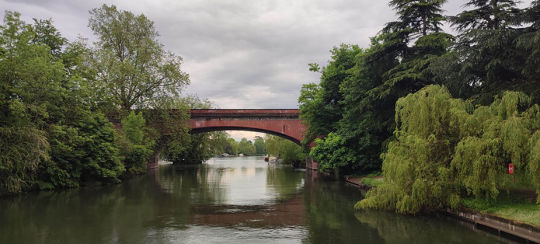
Location
The Maidenhead Railway Bridge crosses the River Thames in Maidenhead, Berkshire. The bridge can be viewed from Guards Club Park and its accompanying island.
History
The Maidenhead Railway Bridge, also known as the Maidenhead Viaduct was constructed in 1838. The bridge carries the Great Western Main Line (GWML) over the River Thames between Maidenhead, Berkshire, and Taplow, Buckinghamshire.
When it was built, Maidenhead Bridge boasted the flattest yet widest brick constructed arches in the world.
From 1890-1892 the Bridge is widened on both sides by Sir John Fowler; and in 2009, the lines were electrified.
What's there?
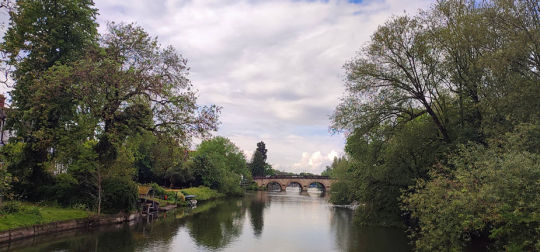
With the use of the bridge between the Guards Club Park and island you can see the Maidenhead Railway Bridge, as well as the 13th century Maidenhead Bridge.
At the Guards Club Park you will find:
Open green space ideal for small dog walks
Riverside views
Gazebo (pictured at the bottom of the page)
Access bridge to Guards Club Island
View of Maidenhead Railway Bridge
View of Maidenhead Bridge

Parking
There is a small car park on site. Parking is free, and the gates are locked half an hour before sunset.
There are no specified disabled parking spaces.
Accessibility
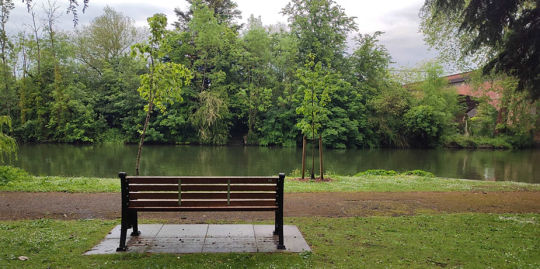
Due to its small size and plentiful benches, Guards Club Park is ideal for visitors who struggle to walk long distances. There are less than 50 metres to walk to reach the river, with a view of the bridges.
There is no path from the car park to the riverside, but the grass is fairly level, so it should not be an issue for wheelchair or mobility scooter users.
There are a few steps to access the bridge, making it not accessible for wheelchair users, but you can still see the bridges from is riverside path.

Conclusion
Overall, getting a view of the bridge is accessible for people of all ages and abilities. The park tends to be quiet and peaceful throughout the day.
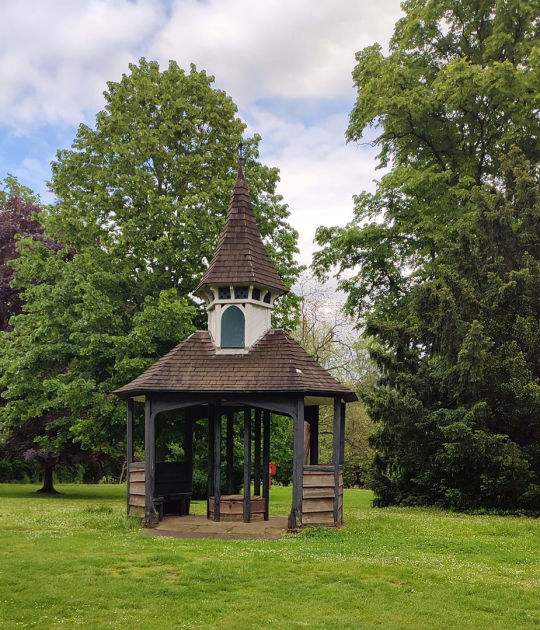
#health#accessibledaytrips#accessibility#accessibletravel#daytripideas#dysautonomia#pots#wheelchair#travel#maidenhead#railway
1 note
·
View note
Text
Shere
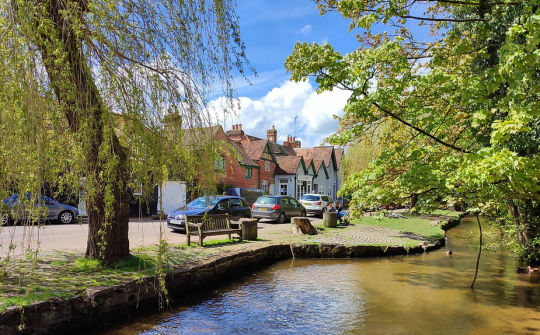
Location
Shere is a picturesque village located between the towns of Guildford and Dorking. The village is home to many charming historic buildings, including the 12th-century St James Church. There are lots of small shops, cafes, and pubs, as well as a stream that runs through the centre of the village.
Shere is surrounded by beautiful countryside and is a short distance from Newlands Corner, one of the most popular parts of the Surrey Hills.
Shere has been featured in many films and tv shows, including Silent Witness, Bridget Jones, and The Mummy (2017). For the full list - Click Here
What's there?

Local shops and facilities include:
The White Horse pub
The Bray pub
The Dabbling Duck Cafe
Shere Delights ice cream shop
Playground
Museum
Stream views
Public toilets
And much more
Parking
Shere car park is free to use, and is located a short walk from the centre of the village (about 100 metres). There are 3 blue-badge parking spaces. This car park can be busy during peak seasons.
When visiting during less busy periods, you can also find parking on Lower Street, next to the stream. There are also a few places to park by St James Church.
Accessibility

Shere is accessible for visitors who struggle to walk long distances, due to its small size and useful parking location. There are benches facing the stream in the village centre, as well as a seating area (pictured above).
Shere is wheelchair accessible, with plenty of paths with dropped curbs. There are some slight hills, particularly up to the church.
Conclusion
Overall, Shere has something to offer visitors of all ages and abilities. The village has lots of history and wonderful views. With a plentiful option of cafes, pubs, and shops, as well as the kids playground, Shere is a great place to visit with the family.
Visiting during the holidays can be busy, but outside of busy seasons, Shere remains a very peaceful and relaxing village to visit.
For more info, visit:
#health#accessibledaytrips#accessibility#accessible travel#daytripideas#travel#wheelchair#dysautonomia#surrey#guildford#Shere
1 note
·
View note
Text
How to Manage Dysautonomia Symptoms

What is Dysautonomia?
Dysautonomia is an umbrella term for health conditions related to the autonomic nervous system. The term "autonomic" means ”self-governing,” which means it controls things you don't have to think about. This covers a wide range of bodily functions, such as breathing, digestion, heart rate, blood pressure, body temperature, sweating and much more. Some of the most common forms include POTS, orthostatic hypotension, vasovagal syncope and autonomic dysreflexia.
Tips for Managing Dysautonomia
There are many types of dysautonomia, and there's no quick fix, but with some lifestyle adjustments things can get easier. This list aims to give some useful tips and tricks to help manage and keep unwanted symptoms at bay.
Hydration
Staying well hydrated can help with many forms of dysautonomia, especially those related to blood pressure, such as POTS.
Adults are recommended to drink 3 litres throughout the day to maintain a healthy level of hydration. This can also include diet changes to foods with more fluid, such as custard, cream, yoghurt, ice cream, sorbet, ice pops, ice lollies, ice cubes, slushies, jelly, soup, gravy and sauces.
Hydration tablets can also be a useful way to maximise the hydration you receive while drinking.
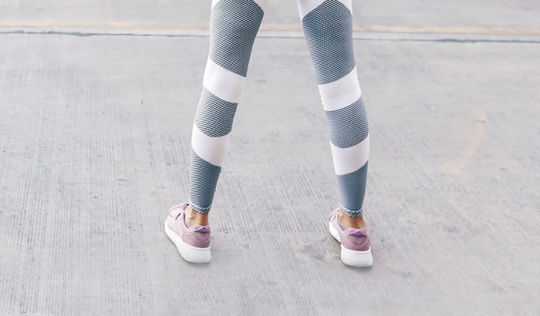
Another way to aid the body in maintaining blood pressure is by wearing compression clothing. Compression stockings are designed to squeeze the legs to help blood flow back to the heart. It is recommended to use medical grade level 2 for optimum results.
While stockings are most commonly recommended, studies have found that compressing both legs and abdomen was more effective than compressing only the legs. Abdominal binders may be more effective than using stockings alone.
Small meal sizes
After eating a large meal, lots of our blood is redirected to the stomach to aid in digestion, which can cause a rise in unwanted symptoms. Therefore, it is recommended to eat several smaller meals throughout the day rather than two or three large ones.
Keeping cool
Heat can be a trigger for people with autonomic dysfunction.
To keep cool, you can use:
Portable fans
Water spray bottle
Cooling towels, mats, pillows and vests
Pace yourself
Whether you are doing housework or spending time outdoors, pacing yourself can help stop fatigue and burnout. Taking things slowly can pay off in the long run, minimising long term symptoms after pushing yourself too hard.
For example, when cleaning, make a plan to work in sections and small bursts, or even spread the task over multiple days.
Pacing yourself during social occasions and giving yourself time to recover can also be very important as well. Connecting in alternative ways, such as video calls and online messaging, can help keep you connected while taking less of a physical strain.

Meditation can help to activate the vagus nerve and calm an overactive nervous system. Meditation and mindfulness practices can lower heart rates and are an accessible form of self-care everyone can use, with plenty of resources online.
Prioritise rest
Prioritising rest is important for everyone, but especially those with chronic illnesses.
Sleep disorders can be common in individuals with autonomic dysfunction. You can maintain good sleep hygiene by following a nighttime routine, avoiding screens before bed, and practicing relaxation techniques. For more information on sleep hygiene Click Here
Learning to say no
Saying no is an important form of self-care, as you are putting your health first. This can be difficult at first, especially if prior to your illness you always made yourself available. Saying no when you are feeling strained and need a break can stop flare ups and a worsening of symptoms in the long run.

The use of physical aids such as wheelchairs and mobility scooters can help to increase your mobility and independence.
Alternatively, the use of electric bikes can be a great option for those who feel uncomfortable using wheelchairs or mobility scooters. E-bikes can also offer low-level exercise and aid users in travelling greater distances independently.
If you struggle to walk long distances, a lightweight camping stool can be useful when there's a lack of benches.
Ask for help
If you have recently become sick, asking for help can feel very difficult, especially if you were previously an independent person. Asking for help can lower your physical strain, and your friends and family will most likely be happy to lend a hand.
Avoid Triggers
Dysautonomia has many triggers; some of the most common include:
Heat
Standing for long periods of time
Physical exertion
Large meals
Dehydration
Stimulants such as tea, coffee, or alcohol
Keeping a diary of your health and daily activities can help you recognise possible triggers. Some symptoms of dysautonomia can be delayed and only appear a few days after their cause; for example, you might feel okay after a walk and then have a worsening of symptoms two days later.
Medication
There are many lifestyle changes that help to control dysautonomia symptoms, but seeing a doctor is very important. A doctor can diagnose you and offer medication to help manage your illness. It's usually a combination of lifestyle changes and medication that will help balance your illness.
For more information on the process of getting a dysautonomia diagnosis Click Here
1 note
·
View note
Text
Hurst Park

Location
Located a few miles from Hampton Court Palace, Hurst Park is a popular open green space for dog walkers and families, but it's also accessible for less able visitors too.
At Hurst Park you will find:
Open fields
River views
Basketball court
Children's playground
Public toilet
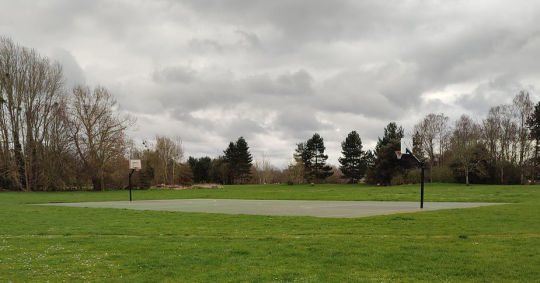
Parking
Parking at this location is free. The car park is large, with 3 disabled parking spaces spread between each of the sections.
There is a height limit of 2.1 metres.
Opening times:
Monday to Friday - 7.30am
Saturdays, Sundays and Bank Holidays - 9am
The car park is locked at dusk.
Accessibility

Hurst Park has plenty of benches located throughout its grounds, about every 25-50 metres or so, making it ideal for visitors who struggle to walk long distances. With benches being most frequent towards the end of the car park, where the road meets the river.
The paths are suitable for wheelchair and mobility scooter users, but they are a bit bumpy, with puddles in places. Image of the river side path is included below.
There is a single accessible toilet near the car park entrance.
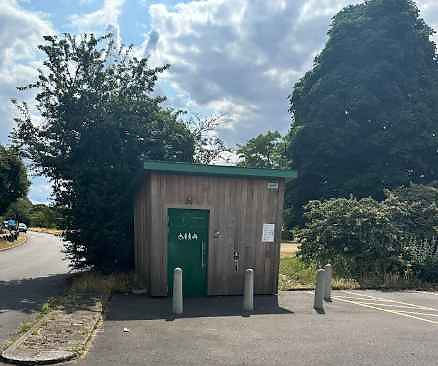
Accessible Public Toilet
Conclusion
Overall, Hurst Park is a great place to visit for people of all ages and abilities. Its large fields, kids play area and river views make this location ideal for dog owners and families with young children. Hurst Park is also a good place to stop for lunch, with plenty of benches throughout the grounds.
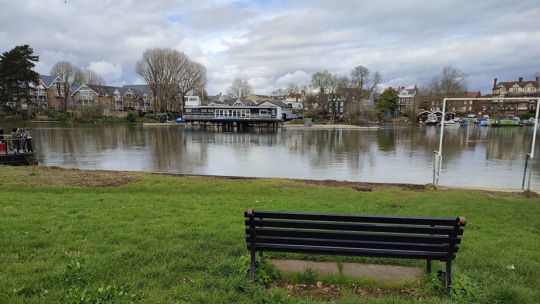
#health#accessibledaytrips#accessibility#accessible travel#daytripideas#travel#wheelchair#dysautonomia#surrey
1 note
·
View note
Text
Tilgate Lake

Location
Tilgate Lake is the biggest of three lakes at Tilgate Park, and is a popular water activity centre. The lake is used for various water sports including, sailing, canoeing, rowing and much more.
What's there?
At the lake you will find:
Lake views
The lakeside cafe and lunch area
Fishing swims
At Tilgate park, you can also find Go Ape, Smith & Western restaurant, playground, and Tilgate Nature Centre.
The Lakeside Cafe is open from 10am to 4pm on weekdays, with a later closing time of 5pm on weekends.
Fishing
This is a day-ticket water, with tickets available from Crawley Borough Council. There are many fish species available to be caught at Tilgate Lake, including carp, pike, tench and bronze bream, perch, crucian carp, roach and rudd.
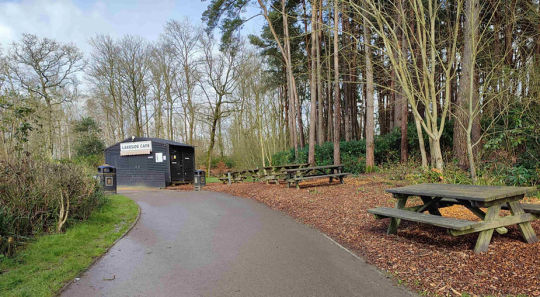
Parking
Tilgate Fisherman's car park is located just before the golf course on Tilgate Drive. It is open all day, every day including bank holidays. There is a 2.1m height restriction.
There are 8 disabled parking spaces.
Pay and Display price:
£1.20 Per hour, up to four hours
£6.00 Over four hours (up to 24 hours)
Parking is free for blue badge holders.
Accessibility
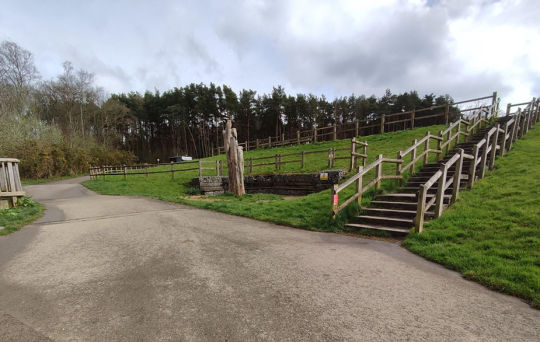
Path and stairs to lake
There is a short walk (around 50 metres) from the fisherman's car park to the lake. To access the lake, there is a slope with the option of taking stairs or a wheelchair accessible ramp.
There are benches about every 50 metres around the lake.
Tilgate Lake is accessible for wheelchair and mobility scooter users, with ramps and smooth paths.
The nearest public toilets are in the main Tilgate car park.
Conclusion
Overall, Tilgate Lake is an ideal place to visit for people of all ages and abilities. With its cafe and lakeside views, this location is a perfect place to stop for lunch. The lake is also dog friendly, but they must stay on the leed.
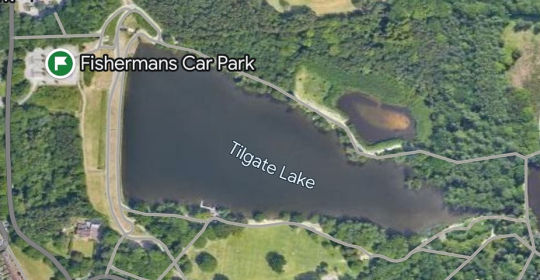
#health#accessibledaytrips#accessibility#accessible travel#daytripideas#travel#wheelchair#dysautonomia#crawley
1 note
·
View note
Text
Travelling with POTS or Dysautonomia-Tips and Tricks
Introduction
After being diagnosed with post-covid dysautonomia in 2021, the thought of travelling again seemed near impossible, but over the past few years I have learned that this is not the case. In this post, I aim to share some tips and tricks on how to make your trips more manageable.
What is dysautonomia?
Dysautonomia is an umbrella term for health conditions related to the autonomic nervous system. The term "autonomic" means ”self-governing,” meaning it controls things you don't have to think about. That includes your blood pressure, body temperature, breathing, digestion, heart rate, sweating and much more. Some of the most common forms include POTS, orthostatic hypotension, vasovagal syncope and autonomic dysreflexia.
Travelling with POTS or Dysautonomia
Preparation
Before your trip there will be a few things to check off your list.
Medication: its important to make sure you have plenty of medication to last the trip. This could also include things like compression stockings or ibuprofen if you get a tight chest.
Food: bringing a few meals with you can save a trip to the shops while you are away, leaving you with more energy for the fun stuff. This can also come in handy if you feel worn-out during your trip.
Hydration: in the days before your trip, increasing your hydration will make sure your body is in the best possible condition before you start your journey.
Research, Find what's right for you
Whether it's a day trip or week away, its best to know a bit about where you are going. The first thing to consider is your accommodation; are you looking for a hotel, Airbnb or camp site?
Things you should look out for include:
The parking availability
Stairs
Air conditioning, if you are going away in the summer.
Pace yourself
When you are away, taking things slowly can pay off in the long run. Whether it's making sure to stop and rest while walking or planning rest days during your trip, this can stop burnout and save you from straining yourself during your holiday.
Be flexible
Have plenty of options that account for your health. Having a plan for good and bad health days can be very reassuring; it's great to plan bigger days out where you will be more active, while also having a backup plan in case of down days.
Continue your regular self-care
While you are away, it's best to not forget your regular self-care routines. Making sure you drink before getting up in the morning, and maintain hydration during the day is even more important than normal, as you will likely be more active during your trip.
Getting enough sleep is also important for people suffering with POTS; continuing your sleep routine will help your body stay in rhythm and well rested.
Also, continuing meditation and breathing exercises is a great way to calm your nervous system after busy days out.
Useful items to take with you
Some items I would recommend are:
Hydration tablets: these will help you maintain your blood pressure throughout the day.
Camping stool: These are great if you are going somewhere that may not have many places to rest.
Small bag: using a smaller bag can save on weight, making walking easier. These can carry extra medication in case you have a flair-up, as well as a small packed lunch.
Water bottles. I usually bring a large bottle to keep in the car and a smaller one for when I'm out and about.
Handheld fans: These can also be a great option to keep yourself cool during the summer, as heat can be a trigger for people with POTS.
#accessibility#accessible travel#accessibledaytrips#health#travel#daytripideas#blog#pots syndrome#dysautonomia
2 notes
·
View notes
Text
Broadwater Park

What's there?
Broadwater Park is located next to Godalming Leisure Centre and is open seven days a week.
Park facilities include:
Woodland paths
A large lake
Games Fields
Tennis courts
Football and cricket pitches
Kids play area
Public Toilets
Broadwater Park is a Green Flag Award winner. To win, parks must meet high standards and have excellent facilities. For further information, and to find other Green Flag parks and open spaces, visit the Green Flag Award website.
Parking
Parking at Broadwater is free. The car park is medium-sized, and there are 4 disabled parking bays. There is also parking available at the leisure centre, located 100 metres further from the park.

Ramp and Blue Badge parking
Accessibility
With a ramp next to the blue badge parking spaces, this location is ideal for wheelchair users.
From the ramp, there's a short distance (less than 50 metres) to the lake. The public toilets and lunch tables are 50 metres from the car park. The kids play area and games fields are just a bit further, around 100 metres from the car park.
From the other side of the car park, you can also walk along a level but slightly muddy path (pictured at the bottom of the page) around 50 metres to a picnic/seating area overlooking the lake. Further from here, there's a small wooded area, and then rugby pitches.
The public toilets are accessible for disabled visitors.
Conclusion
Overall, Broadwater Park is a great place to visit for people with health conditions such as POTS, with plenty of places to stop and rest. There's lots of space and level paths, making this location ideal for wheelchair users as well as parents with pushchairs too. With the kids playground and lake, this location is ideal for young families.
For more info visit-
https://www.accessibledaytrips.com/post/broadwater-park-godalming
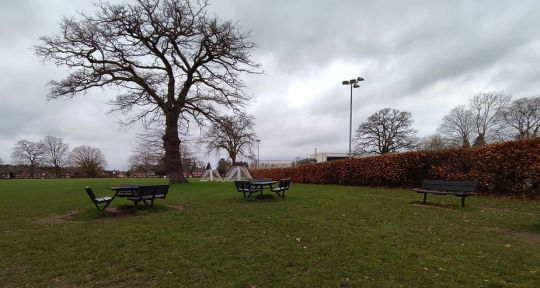
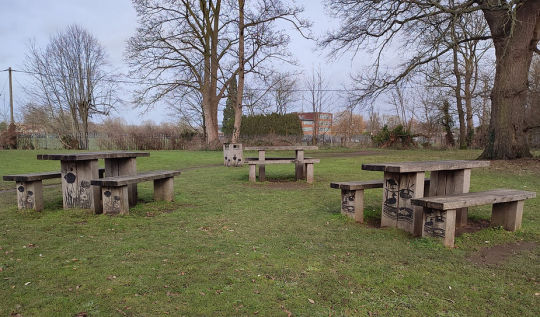
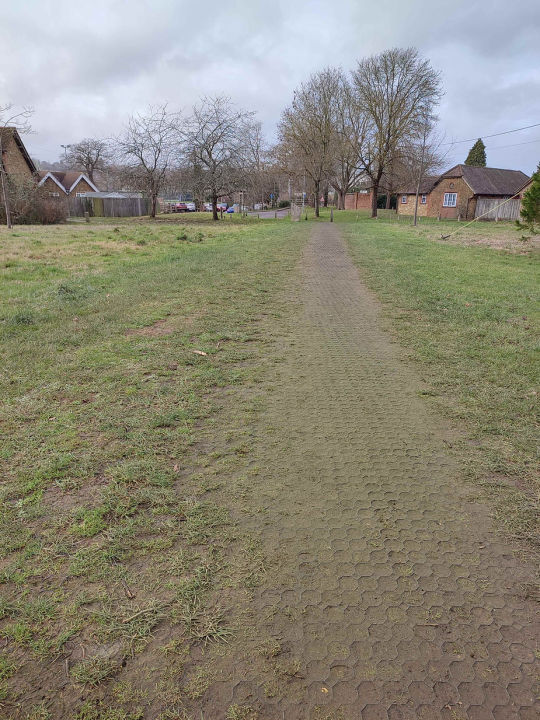


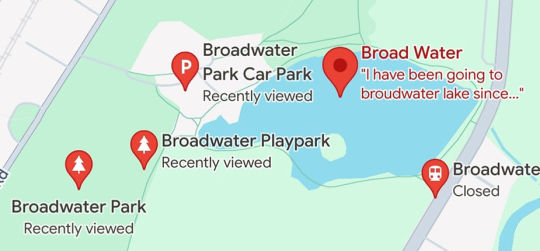
#accessibledaytrips#health#accessibility#accessible travel#daytripideas#travel#wheelchair#surrey#guildford#godalming
1 note
·
View note
Text
Dashwood Mausoleum

Location
The Dashwood Mausoleum is located at the top of West Wycombe Hill, in Buckinghamshire, England. The Mausoleum is situated behind St Lawrence Church, which dates back to the 14th century, although it has been remodelled many times throughout its history. This location is a part of the Chiltern Hills (AONB).
History

Inside Dashwood Mausoleum
The Dashwood Mausoleum was built in 1765, on the site of an Iron Age Hill Fort. It houses the urns containing the ashes of the Dashwood family.
In the 18th century, one of the members of the Hell Fire Club, Paul Whitehead, left Sir Francis Dashwood his heart. After his funeral, which included canons being shot out the side the mausoleum, his heart was placed in an urn in the Mausoleum. The heart used to be passed around tour groups in the 18th century, until an Australian soldier stole the it. It has been missing ever since. The ghost of Paul Whitehead has been seen in many spots in the village, including the caves where the originally empty urn is now kept.
Click here to learn more about the Hellfire Club and its history.
Parking
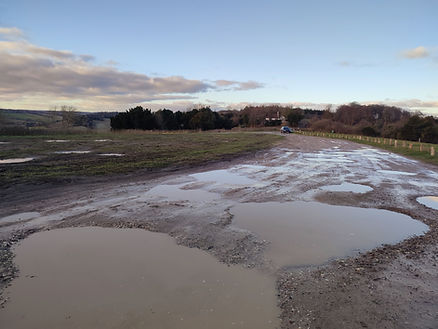
Hilltop car park, with lots of potholes
Accessibility
There is a just over 100-metre walk from the car park to the mausoleum, which takes you either through the church grounds or around an outer path.
The paths are a bit bumpy with some small slopes. The church is accessible for wheelchair users, but the paths to the mausoleum may be too uneven.
There is a bench when you reach the front of the mausoleum. During good weather, the hill is a popular place for picnics, with plenty of places to sit around the hillside and a view over High Wycombe.
Conclusion
Overall, this location has a lot to offer, with great views and a rich history. It's ideal for visitors who struggle to walk long distances.
Visit https://www.accessibledaytrips.com/ for more
1 note
·
View note
Text
Steyne Gardens
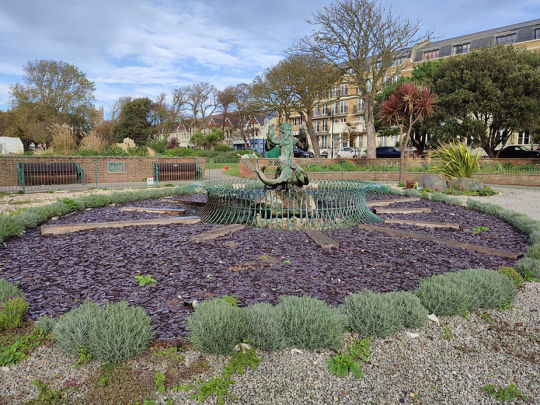
Location
Located in the centre of Worthing, Steyne Gardens offers an open green space great for picnics. At the southern end of the gardens, facing the sea, is a war memorial commemorating the Boer War. The site is used for various events throughout the year, including the Seafront Fayre in summer and the Worthing Ice Rink in winter.
Parking
There are parking spaces along the road around the Gardens. There have always been spaces during my visits on weekdays, but parking may be more difficult during peak times, such as the summer holidays. An alternative place to park is along the Marine Parade.
Pay-and-display parking is £1.20 per hour, and you can park for a maximum of 4 hours.
Parking is free for those with blue badges.
Accessibility
With a length of approximately 175 metres, and plenty of benches, Steyne Gardens are a great place to visit for people who struggle to walk long distances. The paths are suitable for wheelchair and mobility scooter users.
Conclusion
Overall, with its well maintained gardens, Steyne Gardens is an ideal place to stop for lunch or a picnic. Its close proximity to the beach and local shops make it a good place to park to access some of Worthing's main attractions. To find out more about Worthing's pier and seafront, visit https://www.accessibledaytrips.com/post/worthing-pier-and-beach
1 note
·
View note
Text
Millmead Lock Guildford
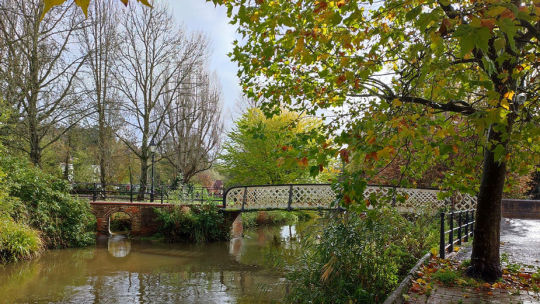
Location
Millmead Lock is located along the River Wey, just outside Guildford town centre. It's a quiet place, with open green areas great for picnics. There are plenty of benches around this location, with views of the picturesque lock and river.

Parking

The Millmead Car Park is located right next to the River Wey. It's pay and display, with a maximum stay of 2 hours. There are around 30 spaces, making it rather small, but I have always been able to find a place to park. An alternative place to park is the "Portsmouth Road Car Park," located 200 metres away, just down the road.
Parking is free for visitors with a blue badge.
Accessibility
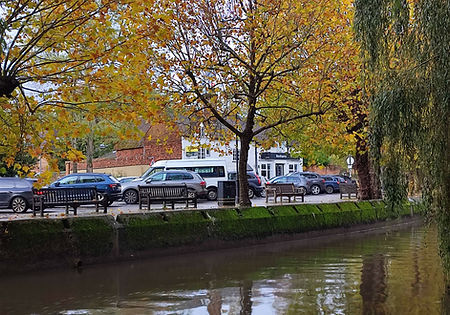
Benches along the river, with car park behind
With plenty of benches and places to rest, Millmead Lock is a great place to visit for people with POTS, or any other condition that makes walking long distances a challenge. The car park is right next to the river, so there is very little distance needed to travel.
The paths are level and the bridge across the river (pictured below) is suitable for wheelchair users. The car park is tight, so this could be an added difficulty for some visitors.
Conclusion
Overall, Millmead Lock is a great place to visit. With its open space and quiet location, the lock is an ideal picnic spot to get away from the busyness of Guildford town centre.
#accessibility#accessible travel#accessibledaytrips#health#travel#wheelchair#daytripideas#surrey#guildford
1 note
·
View note
Text
Devil's Dyke
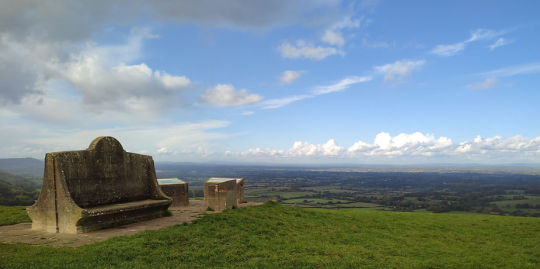
Location
Devil's Dyke is a 100 metre deep valley on the South Downs in Sussex in southern England, 5 miles north-west of Brighton. There is a National Trust car park right at the top, with wide views of the surrounding countryside. The Devil's Dyke Vintage Inn Pub, adjacent to the car park, is a great place to stop for lunch and is dog friendly. Driving there, you will pass through the hills of the south downs, An Area of Outstanding Natural Beauty (AONB). Famous painter John Constable described the panorama from Devil’s Dyke as 'the grandest view in the world'.
Parking
Devil's Dyke car park is Pay & Display. £1.50 for 1 hour; £3 for up to 2 hours; £6 all day. National Trust members and Blue Badge holders park free. There are disabled parking spaces located at the entrance to the pub, and on the right as you enter the National Trust car park.
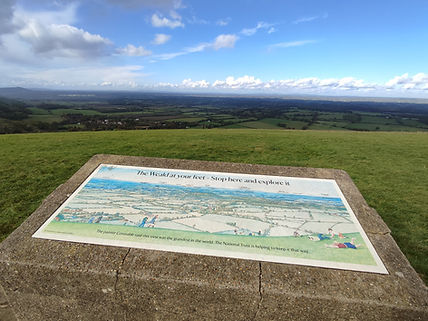
Viewpoint
Devil's Dyke car park is Pay & Display. £1.50 for 1 hour; £3 for up to 2 hours; £6 all day. National Trust members and Blue Badge holders park free. There are disabled parking spaces located at the entrance to the pub, and on the right as you enter the National Trust car park.
Accessibility
With the car park at the top of the hill, you get great views without needing to leave the car. The main view point is 20 metres from the car park and shares information on the surrounding area. The ground around the hill is bumpy so may not be suitable for all visitors.
Hidden Viewpoint
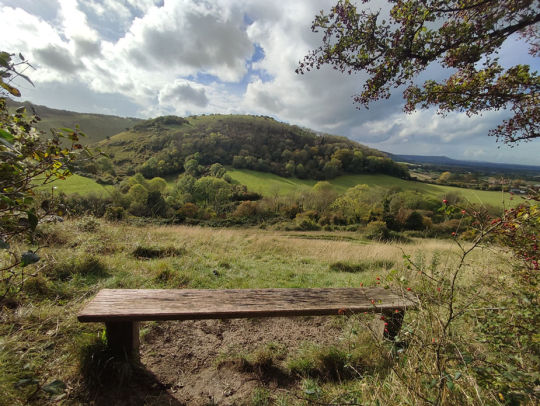
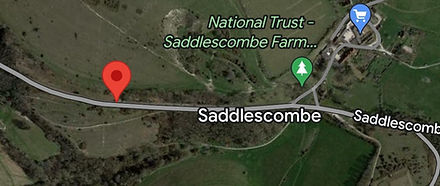
There are multiple places to park during your journey; my personal favourite is along saddlescome Rd, just 5 minutes from the National Trust car park. There are a few spaces at the side of the road with a view of the hills.
This is a quiet location, with few other visitors. Walking a few metres down the hill, you will find a secluded bench with views over local farmland. This can be a great place to stop for lunch or a picnic. The path to the bench is uneven and bumpy, so it won't be accessible for all visitors, but it's only a few meters off the road so there's not a long walking distance.
Conclusion
Overall, Devils Dyke is a great place to visit, even for less able visitors, with its famous views and accessible parking. The drive through the hills offer a view of the countryside and can be a good place to stop on your way to Brighton or other seaside towns.
#accessibility#accessible travel#accessibledaytrips#health#travel#wheelchair#daytripideas#south downs national park
1 note
·
View note
Text
Newlands Corner

What's There?
Newlands Corner is a popular beauty spot with some of the best views over the Surrey Hills. There's a café with a good selection of food, drinks and ice cream. There is also a discovery centre with information on wildlife and the surrounding area. Around the back of the centre there is a small play area for kids, there are also public toilets near the car park entrance.
Parking and Accessibility
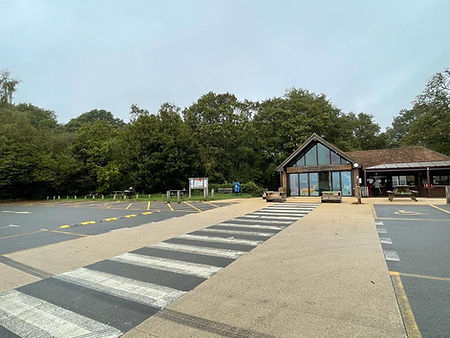
Parking is free and there are usually plenty of spaces. There are nine disabled parking bays, some of which face out with a view from the hill and some next to the café and Discovery Centre. There are also a multiple parking bays not labelled as disabled but still have room for loading a mobility scooter or wheelchair. The total length of the carpark is around 100 meters but it is rarely full.
The café and discovery centre are wheelchair accessible and right next to the car park. In 2022, the Newlands Corner Dormouse Trail was resurfaced to make it more accessible for wheelchair and mobility scooters users but it does lack seating, so for people myself who need to take breaks, it's still not fully accessible for some visitors.

How To Get There
Driving there you will pass through picturesque villages and the Surrey hills, the route is popular for motorbike riders and cyclists with it's narrow winding lanes. I'd recommend taking the scenic route as the journey can be a part of the experience with this trip.
You can visit https://www.visitsurrey.com/ideas-and-inspiration/itineraries/a-drive-through-the-surrey-hills to learn more about driving through Surrey hills.
Bus route
Monday to Friday there is a bus route that stops at the top of the hill every two hours, with connections to Guildford and the surrounding towns.
When to visit

Conclusion
Newlands Corner has something for people of all abilities and ages, with great views and facilities. With free parking and a great café its one of the most popular beauty spots in surrey, I would highly recommend a visit.
1 note
·
View note
Text
Climping Beach

Climping Beach is a pebble and shingle beach located in West Sussex, England, known for its peaceful rural setting. It has been designated as a biological Site of Special Scientific Interest (SSSI) and is also a Local Nature Reserve.
Dogs are welcome on the beach all year round, making it a popular spot for dog walkers.
However, the area has become neglected over time. Large pebble sea defences now block the views from the car park and make it more difficult to access the beach than in the past. Additionally, all amenities such as toilets and cafes have closed, so visitors should plan accordingly.
Parking

There is a medium-sized car park with space for around 18 cars. There are no disabled parking spaces. Parking is free.
Accessibility
The steep slopes and stony surfaces unfortunately make this location unsuitable for visitors with limited mobility.
Visitors who struggle to walk long distances but can climb short, steep slopes may manage at this location due to the beachside parking.
Conclusion
Due to its lack of accessibility features, Climping Beach is unfortunately hard to recommend for visitors with limited mobility. Its isolated location helps keep it quiet and peaceful. If you are able to visit, you'll experience a unique coastline away from crowds, perfect for those seeking tranquillity.
Visitors can find more accessible beaches nearby at Bognor Regis or Worthing.
#health#accessibledaytrips#accessibility#accessibletravel#daytripideas#wheelchair#travel#wellness#pots#beach#climping#climpingbeach#Littlehampton
0 notes